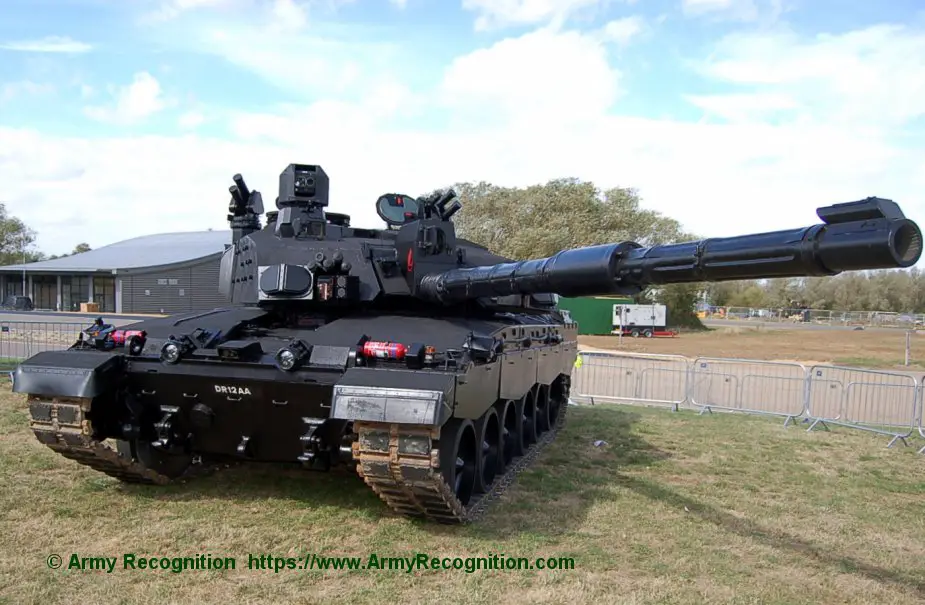Breaking news
DVD 2018: BAE Systems displays Challenger 2 LEP nicknamed Black Night.
The Challenger 2 Life Extension Project (LEP) is a British MoD contract to remove obsolescence from Challenger 2 and extend its out-of-service date by ten years to 2035. As well as removing obsolescence, there will be the opportunity to make further capability enhancements. The upgraded tank will be referred to as Challenger 2 Mark 2. The prototype has been displayed at DVD 2018, painted in black to justify its nickname: “Black Knight”.

BAE Systems' Challenger 2 LEP "Black Knight" (Picture source: Army Recognition)
BAE Systems launched Team Challenger 2, a major strategic partnership with other world-leading defense companies to bid for the LEP Assessment Phase contract. Upgrades to address the Challenger 2’s obsolescence by Team Challenger 2 are as follows: a new thermal imaging system allowing the Challenger 2 to acquire targets at night as quickly as it currently can in daylight would be provided by Leonardo-Finmeccanica (formerly Selex ES Ltd) of Italy; France’s Safran Eletronics & Defence (formerly Sagem) is set to provide a Paseo commander’s sight; General Dynamics Land Systems-UK would install the same digital architecture as the Ajax armoured reconnaissance vehicle that the United Kingdom has purchased as part of the Scout SV programme. K). Other partners in Team Challenger 2 are Moog, QinetiQ and General Dynamics Mission Systems-Canada.
At the beginning of the assessment phase, Simon Jackson, BAE Systems’ campaign lead explained: “We will be giving the Royal Armoured Corps a Challenger 2 Mark 2, customised for the British soldier with the latest and best sensors, weapons control systems and crew stations. When a crew climbs into the Challenger 2 Mk.2, the first thing they will see is a brand new, modern Commander’s crewstation designed specifically for the British Army. All systems - including lethality, sighting, situational awareness, battlefield management and survivability - will be run and managed from this integrated crewstation.”
“A modern electronic and video architecture backbone underpinning all vehicle systems will enable the Commander to transfer tasks to other crew members, such as the control and viewing of additional sensors and systems. Crew menus and displays will be more intuitive and have the same functionality as Ajax - making it much easier for commanders to move between Challenger 2 and Ajax and vice-versa.” “New control panels, the latest hand controllers and intelligent flat panel displays will give an instant feel of a more modern vehicle with major improvements. We will provide improved survivability measures, a better hit probability, faster targeting and vastly improved sighting systems.”
Using an Open Architecture approach means that future upgrades will be incorporated more easily. Team Challenger 2 is ensuring that the tank is ready to receive further capability enhancements such as active protection systems, future electronic countermeasures, training systems and enhanced decision support systems.
There are also opportunities to make Challenger 2 forward-compatible with other emerging technologies. By following the UK Ministry of Defence (MoD) Open Architecture approach, the newly updated tank will be capable of operating with unmanned ground and aerial vehicles, and potentially autonomous vehicles. This could mean sharing situational awareness and even coordinating attack or defense with multiple unmanned weapon systems. In addition, Team Challenger 2 offers option packages to enhance protection and lethality. These will include soft and hard kill defensive aids systems, modular armour and a choice of weapon upgrades.
To make it short, the upgrading process encompasses stabilised sighting systems for the commander and gunner, associated control handles, gun control equipment, elements of the fire-control system, and crew displays. Team Challenger 2 uses turret elements that were developed for the Ajax reconnaissance vehicle family destined for the British Army, also displayed at DVD 2018 (four variants among the six created), while Rheinmetall uses its turret development experience gathered mainly with the Leopard 2 MBT.




























